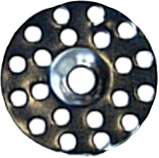

- PLASTER WASHERS INSTALL
- PLASTER WASHERS PATCH

With a gentle touch, determine the area of plaster that's become detached. It flexes when you push on it and sounds hollow when tapped.
Tip: Sagging Plaster: Sometimes you'll see plaster work in your house that seems sound-no holes or cracks-but it's sagging down from a ceiling or bulging out from the walls. (Compound will turn from gray when it's wet to bright white when it's dry.) Step 5: Use a pole sander, as shown, or a similar pad sander, with very fine (150-grit) sandpaper to smooth the compound after it has dried. 
Drying time varies according to the type of compound as well as with the humidity and the amount of ventilation. Step 4: Apply two or three additional coats of compound, allowing complete drying between coats and feathering each coat over a wider area than the preceding one. Or you may embed paper drywall reinforcing tape in the compound immediately after applying it, and smooth with the taping knife.
PLASTER WASHERS PATCH
Step 3: After the patch dries, apply self-adhering Fiberglass reinforcing tape over the patched area and all cracks. Place a working supply of compound in a mud pan (a drywall specialty item) or a bread pan. It works well and cleans easily if you wash it off right away.
Tip: Mix the compound with water using a potato masher. drywall to fit the hole and fasten it with screws to the lath, then cover it with compound. Use a 5-inch taping knife to apply the compound in two stages, scratching the surface of the first coat so the next coat will bond better. Fill small holes with a setting-type joint compound (a powder that must be mixed with water) to almost level it with the surrounding area. Step 2: Mist the area with water first to prevent the dry plaster and wood from drawing moisture out of the compound too quickly. PLASTER WASHERS INSTALL
Tip: To secure loose plaster along cracks, install the screws on both sides and about an inch away from the crack.For large loose areas, install the washers in concentric rings, starting where the plaster is firmly attached and working in toward the loosest area in the middle. To avoid cracking the plaster, drill pilot holes for the screws with a 1/8-in.-diam., carbide-tipped masonry bit. Reattach remaining loose plaster with DP525 Plaster Repair Washers spaced a few inches apart. Step 1: Remove any small, loose chunks of plaster. Old container and stir stick for mixing patching plaster.
 Variable speed drill or screw gun, a cordless model is the most convenient. Drywall sanding screen or sandpaper stiff, narrow paint scraper or old chisel. Self-stick fiberglass mesh drywall tape. No problem! Plaster work is easy to repair, even for the novice, with the a few simple tools, materials and DP525 Plaster Repair Washers. In these areas, the layers of plaster are pulling away from the underlying strips of wood lath which support it. Houses move and breathe, however, much like humans, and over time can develop cracks in the walls and ceilings. Real plaster has a look, feel, acoustic properties and often rich decorative detail that just can't be copied by its modern cost cutting substitute-paper-faced, gypsum-filled wallboard, or drywall. The old houses we love and live in are almost all distinguished by the pervasive use of plasterwork.
Variable speed drill or screw gun, a cordless model is the most convenient. Drywall sanding screen or sandpaper stiff, narrow paint scraper or old chisel. Self-stick fiberglass mesh drywall tape. No problem! Plaster work is easy to repair, even for the novice, with the a few simple tools, materials and DP525 Plaster Repair Washers. In these areas, the layers of plaster are pulling away from the underlying strips of wood lath which support it. Houses move and breathe, however, much like humans, and over time can develop cracks in the walls and ceilings. Real plaster has a look, feel, acoustic properties and often rich decorative detail that just can't be copied by its modern cost cutting substitute-paper-faced, gypsum-filled wallboard, or drywall. The old houses we love and live in are almost all distinguished by the pervasive use of plasterwork.








 0 kommentar(er)
0 kommentar(er)
